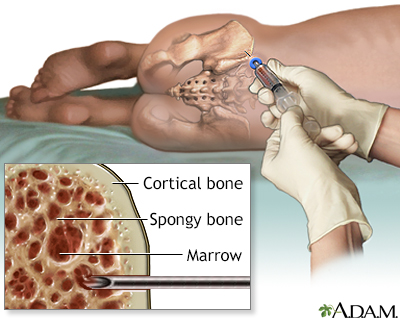Aplastic anemia
Hypoplastic anemia; Bone marrow failure - aplastic anemia
Aplastic anemia is a condition in which the bone marrow does not make enough blood cells. Bone marrow is the soft, tissue in the center of bones that is responsible for producing blood cells and platelets.
Images

I Would Like to Learn About:
Causes
Aplastic anemia results from damage to the blood stem cells. Stem cells are immature cells in the bone marrow that give rise to all blood cell types (red blood cells, white blood cells, and platelets). Injury to the stem cells leads to a decrease in the number of these blood cell types.
Aplastic anemia can be caused by:
- Use of certain medicines or exposure to toxic chemicals (such as chloramphenicol, benzene)
- Exposure to radiation or chemotherapy
- Autoimmune disorders
- Pregnancy
- Viruses
Sometimes, the cause is unknown. In this case, the disorder is called idiopathic aplastic anemia.
Symptoms
Symptoms are due to the underproduction of red cells, white cells, and platelets. Symptoms may be severe from the start or gradually worsen over time as the disease progresses.
Low red cell count (anemia) can cause:
- Fatigue
- Pallor (paleness)
- Rapid heart rate
- Shortness of breath with exercise
- Weakness
- Lightheadedness upon standing
Low white cell count (leukopenia) causes an increased risk for infection.
Low platelet count (thrombocytopenia) can result in bleeding. Symptoms include:
- Bleeding gums
- Easy bruising
- Nose bleeds
- Rash, small pinpoint red marks on the skin (petechiae)
- Frequent or severe infections (less common)
Exams and Tests
Blood tests will show:
- Low red blood cell count (anemia)
- Low white blood cell count (leukopenia)
- Low reticulocyte count (reticulocytes are the youngest red blood cells)
- Low platelet count (thrombocytopenia)
A bone marrow biopsy shows fewer-than-normal blood cells and an increased amount of fat.
Treatment
Mild cases of aplastic anemia that do not have symptoms may not require treatment.
As blood cell counts become lower and symptoms develop, blood and platelets may be given through transfusions. Over time, transfusions may stop working, resulting in very low blood cell counts. This is a life-threatening condition.
Bone marrow, or stem cell transplant may be recommended for younger people. It is more likely to be recommended for those 50 years and younger, but people over 50 may receive a transplant if they are healthy enough. This treatment works best when the donor is a fully-matched brother or sister. This is called a matched sibling donor..
Older people and those who do not have a matched sibling donor are given medicine to suppress the immune system. These medicines may allow the bone marrow to once again make healthy blood cells. But the disease may return (relapse). A bone marrow transplant with an unrelated donor may be tried if these medicines do not help or if the disease comes back after getting better.
Outlook (Prognosis)
Untreated, severe aplastic anemia leads to rapid death. Bone marrow transplant can be very successful in young people. A transplant is also used in older people or when the disease comes back after medicines have stopped working.
Possible Complications
Complications may include:
- Severe infections or bleeding
- Complications of bone marrow transplant
- Reactions to medicines
- Hemochromatosis (buildup of too much iron in the body tissues from many red cell transfusions)
When to Contact a Medical Professional
Contact your health care provider or go to the emergency room if bleeding occurs for no reason, or if bleeding is hard to stop. Contact your provider if you notice frequent infections or unusual fatigue.
Related Information
AnemiaHemolytic anemia
Chemotherapy
Radiation therapy
Toxins
Systemic lupus erythematosus
Thrombocytopenia
Acute
Chronic
Bone marrow transplant
Bone marrow transplant - discharge
References
Culligan D, Watson HG. Blood and bone marrow. In: Cross SS, ed. Underwood's Pathology. 7th ed. Philadelphia, PA: Elsevier; 2019:chap 23.
DeZern AE, Brodsky RA. Aplastic anemia and related bone marrow failure states. In: Goldman L, Cooney KA, eds. Goldman-Cecil Medicine. 27th ed. Philadelphia, PA: Elsevier; 2024:chap 151.
Young NS, Maciejewski JP. Aplastic anemia. In: Hoffman R, Benz EJ, Silberstein LE, et al, eds. Hematology: Basic Principles and Practice. 8th ed. Philadelphia, PA: Elsevier; 2023:chap 31.
BACK TO TOPReview Date: 3/31/2024
Reviewed By: Todd Gersten, MD, Hematology/Oncology, Florida Cancer Specialists & Research Institute, Wellington, FL. Review provided by VeriMed Healthcare Network. Also reviewed by David C. Dugdale, MD, Medical Director, Brenda Conaway, Editorial Director, and the A.D.A.M. Editorial team.

Health Content Provider
06/01/2025
|
A.D.A.M., Inc. is accredited by URAC, for Health Content Provider (www.urac.org). URAC's accreditation program is an independent audit to verify that A.D.A.M. follows rigorous standards of quality and accountability. A.D.A.M. is among the first to achieve this important distinction for online health information and services. Learn more about A.D.A.M.'s editorial policy, editorial process and privacy policy. A.D.A.M. is also a founding member of Hi-Ethics. This site complied with the HONcode standard for trustworthy health information from 1995 to 2022, after which HON (Health On the Net, a not-for-profit organization that promoted transparent and reliable health information online) was discontinued. |
The information provided herein should not be used during any medical emergency or for the diagnosis or treatment of any medical condition. A licensed medical professional should be consulted for diagnosis and treatment of any and all medical conditions. Links to other sites are provided for information only -- they do not constitute endorsements of those other sites. © 1997- 2025 A.D.A.M., a business unit of Ebix, Inc. Any duplication or distribution of the information contained herein is strictly prohibited.
